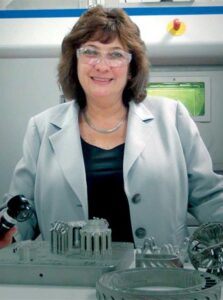How Advanced Manufacturing Technology Is Reinventing an Industry
$1.6 trillion.
That’s how much money was estimated to funnel into global R&D in 2014—three-quarters of which came from the private sector, according to research organization Battelle. Of that portion, it’s not health care, technology, or energy industries that are responsible for most of the aggressive funding—it’s manufacturing. And it’s starting to pay off.
New technologies such as automation, 3-D printing, and predictive maintenance are coming out of R&D labs and being applied up and down the supply chain. Admittedly, manufacturing still has a lingering reputation for stodginess and obsolescence. In a survey by Deloitte and the Manufacturing Institute, it ranked dead last when respondents ages 19 to 33 were asked which industry they’d like to work for. But now, the industry is disproving that stereotype by way of everything from rapid prototyping to smart elevators to zero-waste processes.
Embracing such dynamism has driven manufacturing CEOs to take a direct hand in what used to be considered down-the-line responsibilities: operational technology and sustainability programs. But their involvement has required much more than adding two agenda items at top management meetings. Such innovations as additive manufacturing (commonly known as 3-D printing) are transforming the way manufacturers do business. A strategy for innovation in this hotbed of change relies on execution, which has become as much a part of the CEO’s job as everyone else’s. Manufacturing innovation and sustainability as drivers of the corporate mission have created a whole new set of implementation challenges.
Three global companies, General Electric Co., ThyssenKrupp and Ball Corp., serve as examples. Through them, two lessons become clear:
First, sustainability efforts and advanced manufacturing innovations are best implemented when a concise set of simple objectives and results metrics are employed throughout all divisions of the company. No one needs more silos.
Second, despite the popularity of the term “disruptive change,” the best implementation is achieved through enhancements to existing operational procedures.
Additive Manufacturing and Value Creation at GE
“It can be very expensive and time-consuming to produce a new part conventionally—hundreds of thousands of dollars and three to six months,” says Christine Furstoss, GE Global Research’s vice president and technical director for manufacturing, chemistry and materials technology. As a result, “people can be very reluctant to change design.”nyone who has ever watched a 3-D printer spit layer after layer of plastic or metallic powder to create an object designed by a computer would not be surprised that Fairfield, Connecticut-based GE is spending millions on the technology in the name of speed and disruptive part design. GE, with its 400 global manufacturing plants, makes everything from light bulbs to jet engines, locomotives and power plants. And keeping up with customer demand means it must produce prototypes of new designs and swiftly translate high-potential prototypes into commercial products more quickly than ever.

“We are using additive manufacturing to prototype things very quickly. We are learning, but also getting parts in our hands” more efficiently, she says. “If I can print a part, even if ultimately I’m going to make it conventionally by forging or casting, I get it in people’s hands to learn and test.”
A crucial element to GE’s success in this space is getting buy-in and participation from all levels of the organization, because ramping up additive manufacturing requires all hands on deck companywide. Plant managers skilled at conventional production methods, today known as “subtractive manufacturing,” must feel welcomed, not threatened by their additive manufacturing colleagues. IT experts may not need to be sold on the uses of additive technology, but they need to be comfortable on the shop floor. Commercial developers and customer relations representatives need to be fast learners about demands for additive manufacturing in the marketplace.
“It comes down to the ‘so what?’” questions only senior managers can answer uniformly for employees around the world, Furstoss says. “We don’t want to do things by edict. That adds extra stress, a new layer that may inhibit openness. The whole issue is managing interfaces.”
The result is a new concept of teamwork at GE, she says. Previously, a commercial team joined customers in imagining new products. The commercial team handed off the new idea to a GE engineer team. Finally, a coalition of suppliers and factory managers manufactured what the engineering team had designed.
“The way we work on additive manufacturing is much more collaborative, and there is a bigger player in the game,” Furstoss says. “That is our information technology team. IT and software are bigger partners than ever before.”
With an increased focus on advanced manufacturing comes the need for engaged product teams to discover additive solutions quickly for a particular customer need. At GE, these teams comprise all the traditional teams that operated sequentially.
“This has been a big change for us,” Furstoss says. “We form teams not by hard-line reporting structure” but in interdisciplinary groups, each with its own leader.
Additive manufacturing, which demands broad collaboration, is a principal driver of the structure change, Furstoss says. But “we’re not throwing a new tool at a factory that’s been established and is going well,” she says. “We don’t want to inundate people in a way that they can’t contribute.”
In this regard, additive manufacturing can sell itself internally and encourage acceptance and adoption of the technology. “We put printers right down on the factory floor, where workers may have an idea for a new ergonomic rest for their arm” while they’re working, Furstoss says. “We print it up in hours. They like this idea of being more a part of the process than they ever have before.”
This team approach works in GE’s additive manufacturing operations because every member—from commercial development to engineering to factory operations to IT—understands the business objective behind their fairly free-form collaboration, Furstoss says. The same principles now direct the managers of GE’s many ventures worldwide.
The mindset even applies to fundamental research, which previously meant that the people working in lab coats were not as directly tied to business strategy. Even at the level of fundamental research, “we cannot separate ourselves from the business,” Furstoss says. “If what we’re working on makes it into a product that gives us share and margin, that’s what everyone cares about. It’s a value story. We are constantly relating what this means to quality control and quality assurance. We either kill a proposal quickly or get it into something that is going to give us productivity or margin or share.”
“We don’t want to do things by edict. That adds extra stress, a new layer that may inhibit openness.”
—Christine Furstoss, global technology director for manufacturing and materials, GE
Predictive Maintenance and Culture Shift at ThyssenKrupp
ThyssenKrupp Elevator, headquartered in Essen, Germany, serves customers all over the globe—from the 3.5 million people it lifts up 102 stories every year in New York’s One World Trade Center to the 5,500 office workers in Saudi Arabia’s 1,263-foot CMA Tower, the country’s tallest skyscraper. Such a vast volume of elevators—and the requirement that each ride be safe and swift—required ThyssenKrupp to devise a way to more efficiently monitor each elevator’s status and more quickly perform repairs.

With 1.2 million elevators in service around the world, Andreas Schierenbeck, chairman of ThyssenKrupp AG’s €6.4 billion business area elevator technology division, was frustrated that there seemed to be no way to systematically reduce repair costs. Yet there was no denying the urgency behind the costs.
“If the elevator starts, and you have that feeling in your stomach because the brake slipped, that’s probably not what you want,” he says. “I get a call from a customer who says, ‘It’s not working; send somebody.’”
His team had tried various sensors to anticipate mishaps, but the fact remained that each elevator was potentially its own problem. Then, in late 2013, Schierenbeck “bumped into” then-Microsoft CEO Steve Ballmer at the grand opening of a Microsoft business center in Berlin and told him about the maintenance problem.
“We chatted for about five minutes,” Schierenbeck says. “I’d been working on this for a number of years, and it was going nowhere. I was a little upset because we had too much of a hardware focus. Nobody was talking about software.”
Of course, Ballmer was. “We decided, let’s start something,” Schierenbeck says. “Maybe this will work out. And we started this big project.”
“You have to have the foresight to imagine what technology can do for you, and you have to prepare the organization for cultural change.”
—Andreas Schierenbeck, chairman, ThyssenKrupp Elevator
Schierenbeck partnered with Microsoft and CGI, a large Canadian IT firm, to create a cloud-based elevator monitoring system that would integrate with ThyssenKrupp’s elevators. In each of ThyssenKrupp’s million elevators are thousands of sensors and systems collecting massive amounts of data about everything from temperature and shaft alignment to door function and cab speed. The company’s new monitoring system, first implemented in Seattle-area elevators in the summer of 2014, connects all of the data gathered by those sensors and funnels it into a dashboard that tracks a variety of KPIs for each elevator.
The new system signaled a big shift from the company’s traditional focus on hardware instead of software. “We wanted to go beyond the industry standard of preventive maintenance, to offer predictive and even pre-emptive maintenance,” said Schierenbeck in a statement, “so we can guarantee a higher uptime percentage on our elevators.”
But the technology also meant that ThyssenKrupp’s technicians would begin doing their jobs in a new way. At an organization with 900 locations globally and a long tradition of executing mechanical and electrical solutions for elevator construction and maintenance, the arrival of Microsoft software experts was a bit jarring, Schierenbeck recalls.
“You have to have the foresight to imagine what technology can do for you Share on X , and you have to prepare the organization for cultural change,” he says. “It takes leadership from the top to drive that. It changes the way we are working, and nobody easily embraces change.”
Technicians at control centers and in the field can see all of that real-time information gathered in one place via the cloud. With up to 400 error codes possible on any given elevator, instead of waiting for a frantic call, technicians can pre-emptively assess and quickly react to what needs repairing. The system also permits technicians to remotely enable an elevator’s “diagnostics mode” or send it to a specific floor.
Today, ThyssenKrupp Elevator, working with Microsoft, is the bellwether of parent company ThyssenKrupp AG’s implementation of predictive maintenance—gathering vast quantities of data from discrete units for analysis that foresees trouble at any unit. For the first time at the €41 billion global provider of industrial materials and services, “the Internet of Things is playing a role,” says Schierenbeck.
It’s too early to assess precise cost savings of the elevator maintenance software innovations, he says. But ThyssenKrupp AG units—which include vehicle components and industrial engineering services for auto manufacturing, chemical plants and refineries—are watching closely. Within the elevator group itself, large-scale data gathering and analysis may find a role in maintaining equipment used in manufacturing ThyssenKrupp elevator components, especially in China and other high-growth regions, he adds.
Sustainability and Risk Management at Ball Corp.
To streamline its operations and reduce waste, Ball Corp., the provider of metal packaging for beverages, foods and household products, is implementing sustainability practices across the entire organization. But when CEO John Hayes wanted to hire a U.S.-based global manager of sustainability to oversee the company’s energy and environmental programs at 62 plants around the world, he could not find a candidate. Instead, he chose the company’s sustainability manager in Germany, where environmental goals had been part of corporate management structures for at least 20 years.
The Broomfield, Colorado-based company has implemented sustainability-related programs throughout its 135-year history. The most comprehensive and high-priority initiatives began in 2007 and have become a leading responsibility of senior management under Hayes.
His persistence paved the way for the hiring of Bjoern Kulmann as global director of sustainability. Today, the company has a sustainability steering committee to ensure “that sustainability is fully aligned with and integrated into [Ball’s] strategies, as well as balanced with stakeholder expectations,” according to the company’s governance mission statement. The steering committee reports to the board of directors.
Ball approaches sustainability management under the overarching theme of risk management—risks of climate change, risks to the availability of materials and risks of government environmental regulations.
As the company continues its perennial campaigns for better recycling and energy efficiency, two problems loom larger than before: First, water conservation and availability. Second, the need not only to reduce factory waste in landfills but to eliminate production-induced waste altogether.
Senior management needed a way to put its employees, suppliers and customers on the same page, given the variety of issues and circumstances its sustainability strategy entailed. “Sustainability is a fairly complex concept,” Kulmann says. Reducing water consumption may be a high priority in one region, while boosting recycling rates dominates sustainability efforts in another region.
Goals to eliminate waste seem a harsh reward for plant managers who felt proud to finally to take the local landfill off their daily truck routes.
Ball calls its sustainability program The Big Six, Kulmann says, because it made the program “tangible for our folks on the shop floor. The tagline refers to electricity, natural gas, water, waste, volatile chemical emissions and safety,” he says. “That’s what managers have under their control at their plants everywhere.”
Each of the six elements already was being monitored periodically. Now, each is measured at least monthly using uniform metrics. The resulting data is gathered in both divisional and global reports. The data provides benchmarks that allow precise oversight of highly diverse operations. In addition to better cost-saving metrics, the data enables Ball to provide evidence of its effort to reduce its footprint in environmentally critical areas, such as greenhouse gases and threats to the world water supply.
In North America, Ball has eliminated hauls to the landfill for all but two packaging plants, Kulmann says. All metal scrap is turned over to suppliers and recycled. But the challenge is to eliminate the waste altogether and save on the cost of recycling.
Although reusing materials is environmentally friendly, “you’re running it through the production cycle again,” Kulmann notes. “The most sustainable solution is to avoid the waste in the first place. It’s a tricky topic, especially in the U.S., where we always had a strong focus on reducing waste to the landfill.”
Goals to eliminate waste seem a harsh reward for plant managers who felt proud to finally take the local landfill off their daily truck routes. The new solution may require costly alterations to long-standing production procedures. “It’s a cultural shift that will take a while,” Kulmann says.
The sustainability benchmarking effort, eliminating production waste and reducing water consumption are three companywide goals on senior managers’ plates. Solving such problems helped Ball obtain membership in the Dow Jones Sustainability Indices, traded stock portfolios that comprise companies highly rated in sustainability achievements.



